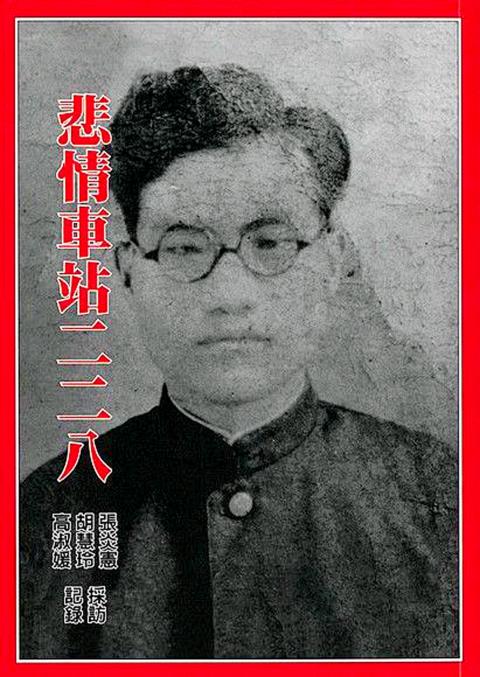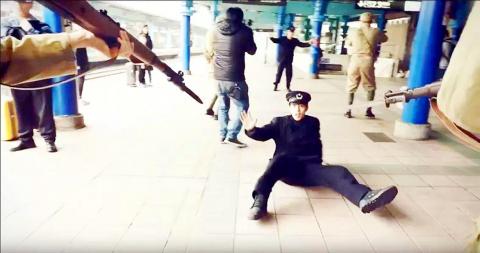Feb. 24 to march 1
Lin Mu-chi (林木杞) recalls being strung with wires through his hands and feet to eight other people. The soldiers took them to the bay and began shooting them one by one. Lin was at the end of the row, and fortunately he was dragged into the ocean by the falling bodies before the soldiers got to him. He managed to break free and swim away, hiding in a cemetery for over 10 days before daring to return home.
Lin was one of the few who survived the carnage that took place in the Keelung area after reinforcement troops from China landed on March 8, 1947, to quell the anti-government uprising that would be known as the 228 Incident. They seemed to kill indiscriminately as Lin was just a floor sweeper, and in the next week, the port would be littered with bodies retrieved from the ocean.

Photo courtesy of books.com.tw
Harrowing tales from that week include the Badu Station incident on March 11, where soldiers shot between five and eight station workers and carted off at least eight more, who were never heard from again. It is believed that they were exacting revenge for their comrades who were beaten at the station by angry civilians on March 1.
PORT OF BLOOD
The violence on March 1 was an extension of the unrest that broke out a day earlier. The Taiwanese initially welcomed the Chinese Nationalist Party (KMT) when it replaced the Japanese colonial government in October 1945, but after over a year of misrule, corruption and rampant inflation, things finally reached the breaking point. Emotions were high that day as the people were fed up with mistreatment by soldiers.

Photo courtesy of Maketuwun Images International
Chou Ching-piao (周清標), who worked at Badu Station at the time of the incident, says in the book Station of Sorrow: 228 (悲情車站二二八) that the soldiers often refused to line up or buy tickets, forcefully taking over entire cars and throwing other passengers’ belongings out the window. Chou assumes the brawl began due to similar behavior.
The fighting began soon after the soldiers boarded at Fulong Station. Badu was a major station with many passengers, who immediately joined the fray. Chou didn’t leave his office, but saw passengers chasing after about 10 soldiers from his window. Most of them were injured, and one reportedly drowned while trying to run away.
Station master Lee Tan-hsiu (李丹修) reportedly helped treat the soldiers’ wounds and let them stay in the station until the passengers dispersed. They thought that this was the end of it.

Photo courtesy of Wikimedia Commons
On March 8, KMT reinforcements landed in Keelung from China. The official government report released in 1992 states that in the following week, Keelung Harbor was filled with floating bodies as the troops “cleared out the rebels,” taking away countless men who were never to be seen again from their houses.
One of the first — and more notable — victims was Yang Yuan-ting (楊元丁), then deputy speaker of the Keelung city council. The book Rainy Port Keelung: 228 (基隆雨港二二八) states that Yang often spoke out against the corruption of his fellow officials, making him a prime target once the chaos broke out. It isn’t clear when he died, but his body was found on March 10.
Kuo Chung-mei (郭鍾美) remembers the day the boat carrying the troops arrived.
“I kept hearing gunshots left and right. That was the day where the most people died. There were fewer gunshots the next day, but we heard that they would kill one here and another there. I don’t know where they killed the ones they took away,” she recalled.
Kuo hid at home for the next few days, and when she went out she saw retrieved bodies piled up by the harbor. Then the soldiers started systematically arresting people from each house. Luckily, her family was spared.
STATION MASSACRE
In the morning of March 11, Chou Chiu-chin (周秋金), who lived near Badu Station, heard multiple gunshots coming from the station. His brother Chou Chun-hsien (周春賢) was among those taken away that day. Lee’s son, Lee Wen-ching (李文卿), was staying in the station dorms and witnessed soldiers stabbing two workers to death.
Hsieh Kuo-chuan (謝國全) was one of the fortunate station workers to survive. He recalls that about 20 soldiers led by Shih Kuo-hua (史國華), nephew of the commander in Keelung, surrounded the station and began shooting and stabbing anyone in a railroad uniform. They had planned to kill everyone there, but a Taiwan-born officer named Wang Li-gu (王勵固) who was stationed nearby heard the commotion and stopped the soldiers. Hsieh says that Wang convinced the soldiers to only take away those who were on duty on March 1 — which included Hsieh — but before they got to him, Wang managed to convince them that they had enough.
“I didn’t know that they would all be killed,” recalls Wang Ching-tien (王擎天), who was also stationed in the area. “I thought they would at least be taken to Keelung for a military trial. But I heard later that they were all taken to an abandoned mine and killed there.”
Station workers Hsiung Chin-chuan (熊金川) and Hsu Yen-shan (許炎山) were in Keelung when they were spotted by soldiers. Hsiung got away, but he heard Hsu’s screams as he was dragged off. Hsu’s body was found in a canal after days of searching.
Much of the book deals with how the victims’ loved ones dealt with the aftermath. Lee Wen-ching says the railway administration ignored their requests for assistance. Convinced that his father was dead, whenever his family heard news that a body was found, they would go check if it was him, no matter how far they had to travel. But they never got any answers, and Lee and his brother had to leave school and find work to support the family with their father gone.
“I will never forgive the government,” Chou Chiu-chin says. “My brother didn’t do anything wrong. He didn’t break the law. All he did was go to work. We still don’t know what happened to him. There was no indictment, no verdict.”
Taiwan in Time, a column about Taiwan’s history that is published every Sunday, spotlights important or interesting events around the nation that have anniversaries this week.

This is the year that the demographic crisis will begin to impact people’s lives. This will create pressures on treatment and hiring of foreigners. Regardless of whatever technological breakthroughs happen, the real value will come from digesting and productively applying existing technologies in new and creative ways. INTRODUCING BASIC SERVICES BREAKDOWNS At some point soon, we will begin to witness a breakdown in basic services. Initially, it will be limited and sporadic, but the frequency and newsworthiness of the incidents will only continue to accelerate dramatically in the coming years. Here in central Taiwan, many basic services are severely understaffed, and

Jan. 5 to Jan. 11 Of the more than 3,000km of sugar railway that once criss-crossed central and southern Taiwan, just 16.1km remain in operation today. By the time Dafydd Fell began photographing the network in earnest in 1994, it was already well past its heyday. The system had been significantly cut back, leaving behind abandoned stations, rusting rolling stock and crumbling facilities. This reduction continued during the five years of his documentation, adding urgency to his task. As passenger services had already ceased by then, Fell had to wait for the sugarcane harvest season each year, which typically ran from

It is a soulful folk song, filled with feeling and history: A love-stricken young man tells God about his hopes and dreams of happiness. Generations of Uighurs, the Turkic ethnic minority in China’s Xinjiang region, have played it at parties and weddings. But today, if they download it, play it or share it online, they risk ending up in prison. Besh pede, a popular Uighur folk ballad, is among dozens of Uighur-language songs that have been deemed “problematic” by Xinjiang authorities, according to a recording of a meeting held by police and other local officials in the historic city of Kashgar in

It’s a good thing that 2025 is over. Yes, I fully expect we will look back on the year with nostalgia, once we have experienced this year and 2027. Traditionally at New Years much discourse is devoted to discussing what happened the previous year. Let’s have a look at what didn’t happen. Many bad things did not happen. The People’s Republic of China (PRC) did not attack Taiwan. We didn’t have a massive, destructive earthquake or drought. We didn’t have a major human pandemic. No widespread unemployment or other destructive social events. Nothing serious was done about Taiwan’s swelling birth rate catastrophe.